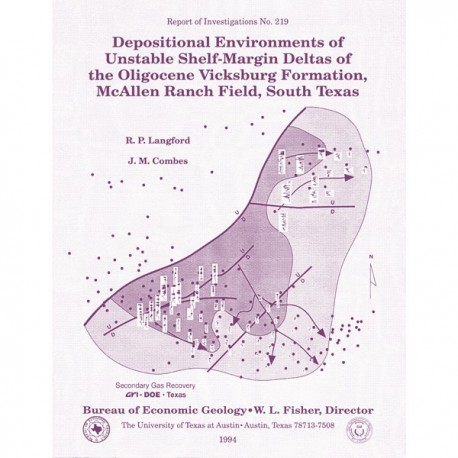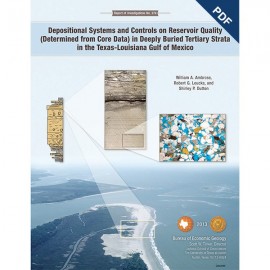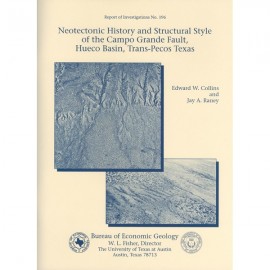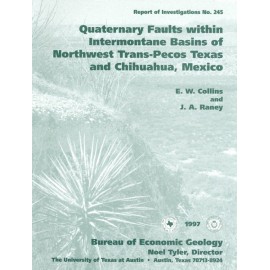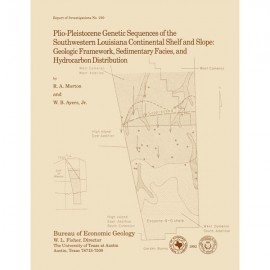Reports of Investigations
-
Books & Reports
- Reports of Investigations
- Guidebooks
- Udden Series
- Geological Circulars
- Down To Earth
- Atlases of Major Oil and Gas Reservoirs
- Texas Memorial Museum Publications
- Environmental Geologic Atlas of the Texas Coastal Zone
- Mineral Resource Circulars
- Other Reports
- Seminars and Workshops
- Handbooks
- Submerged Lands of Texas
- Symposia
- Annual Reports
- Open File Reports
-
Maps & Cross Sections
- Thematic Maps
- Miscellaneous Maps, Charts & Sections
- Geologic Atlas of Texas
- STATEMAP Project Maps
- Geologic Quadrangle Maps
- Cross Sections
- Highway Geology Map
- Energy and Mineral Resource Maps
- Shoreline Change and Other Posters
- Wilcox Group, East Texas, Geological / Hydrological Folios
- Bouguer Gravity Atlas of Texas
- River Basin Regional Studies
- Featured Maps
- Posters
- Teachers & the Public
-
Geological Society Publications
- Gulf Coast Association of Geological Societies
- Alabama Geological Society
- Austin Geological Society
- Corpus Christi Geological Society
- Houston Geological Society
- Lafayette Geological Society
- Mississippi Geological Society
- New Orleans Geological Society
- South Texas Geological Society
- GCS SEPM Publications
- Historic BEG & UT Series
Depositional Environments of Unstable Shelf-Margin Deltas,... Vicksburg Formation, McAllen Ranch Field
RI0219
For a downloadable, digital version: RI0219D.
RI0219. Depositional Environments of Unstable Shelf-Margin Deltas of the Oligocene Vicksburg Formation, McAllen Ranch Field, South Texas, by R. P. Langford and J. M. Combes. 60 p., 27 figs., 3 tables, 1994. Print.
To purchase this publication as a downloadable PDF, please order RI0219D.
ABSTRACT
Cores and supporting petrophysical data from 20 wells in McAllen Ranch field were analyzed. This Vicksburg field lies in northern Hidalgo County near the south end of the Texas Gulf Coastal Plain on the downthrown block of a major growth fault that merges with a glide plane dipping 5 degrees to the east beneath the field. The analyses provided a base for interpreting depositional environments.
We grouped cored strata into four facies: (1) prodelta shales, (2) distal delta-front sandstones and shales, (3) proximal delta-front sandstones, and (4) distributary-channel sandstones. We found that prodelta and distal delta-front deposits contain thinly interbedded sandstone and silty mudstone, which form dip elongate features that we interpreted as density-flow deposits formed within a fluvial-dominated deltaic setting. The proximal delta-front sandstones consist of thick (10- to 120-ft) sandstone beds containing crude, subhorizontal laminae or massive bedding interstratified with less common trough crossbeds, deposited as broad, strike-elongate bodies in a shallower, higher energy, wave-dominated depositional environment. Reworking and northward transport of sediment by longshore current from the southern fluvial-dominated setting created strike-elongate sand bodies in the north. Distributary-channel deposits are common in the apical southwest and west parts of the deltas. These depositional patterns indicate a history of southern fluvial-dominated deltaic deposition and concurrent and subsequent reworking of the distal and north parts of the delta complex into a wave-dominated regime.
The lower Vicksburg deltaic deposits exhibit a complicated history of development of interrelated sedimentation, growth faulting, and diapirism within an overall transgressive environment. Growth faulting localized progradational deltaic deposition into rapidly rotating and subsiding wedges. Rotation and expansion of the section along the growth fault and glide plane also controlled the thickness of the deltaic deposits. The deltaic sediments are thickest along the glide-plane contact and thin dramatically down depositional dip. Transgressions shifted the foci of deltaic deposition and associated growth faulting in a landward direction. Eventually transgressions moved deltaic deposition well to the west of McAllen Ranch field, ending deposition of the unstable shelf-margin deltas. Shale diapirism increased in importance as the depositional loci shifted. An erosional unconformity formed across the distal ends of many deltaic wedges as a diapir rose beneath the field. Subsequent deflation of the diapir produced a depression that was filled by distal shelf siltstones and mudstones.
Understanding this style of deposition can lead to locating and recovering hydrocarbons in Texas because, although relatively common, shelf-margin deltaic reservoirs are difficult to characterize because of their structural and depositional complexity. Because the basal Vicksburg deltas were deposited on distal shelf and upper slope mudstones of the underlying Eocene strata, they are important examples of unstable shelf-margin deltas that accumulated in a setting of active tectonism and deposition.
Keywords: deltas, depositional environments, natural gas, Oligocene, shelf margin, Vicksburg Formation, Texas
CONTENTS
Abstract
Introduction
Purpose
Background and Location
Sources of Data
Methods
Stratigraphic-Eustatic Setting
Tectonic Setting
Depositional Setting
Previous Studies
Depositional Environments and Facies Observed in Cores
Prodelta and Shelf Mudstones and Siltstones
Distal Delta-Front Sandstones and Mudstones
Distal Delta-Front Depositional Environment
Proximal Delta-Front Sandstones
Distributary-Channel Sandstones
Depositional Patterns
Correlation with Electric Logs
Depositional Changes between Wells
Relationships between facies changes down depositional dip
Deltaic lobes changes in thickness of the distal delta-front strata
Areal changes in deposition
Relationships between fluvial-dominated and wave-dominated deposition
Deformation of the Lower Vicksburg Deltas in McAllen Ranch Field
Structural Framework
Structure of a Representative Deltaic Interval
Deposition and Deformation of Successive Deltaic Intervals
Delineation of deltaic packages
Deformation of deltaic packages
Seismic Analysis of the McAllen Ranch Area
Seismic Facies
Depositional Environments and Seismic Facies of the McAllen Ranch Area
Discussion
Summary
Acknowledgments
References
Figures
1. Map of the Texas Gulf Coastal Plain showing McAllen Ranch field and Vicksburg Deltaic Sandstone in the Rio Grande Embayment play (VK-1), along with main faults in the area
2. Northwest-southeast regional dip-oriented cross section A-A' of Rio Grande Embayment showing mid-Tertiary stratigraphy, important faults, and sequence systems tracts
3. Stratigraphic column of McAllen Ranch field area showing stratigraphic nomenclature, correlations with magnetic polarity isochrons, interpretations of sea-level onlap curves, and depositional history of the Gulf Coast Basin
4. Interpreted seismic line in the McAllen Ranch area indicating arrangement of seismic-depositional facies
5. Map of well locations in McAllen Ranch field showing cored wells, cross sections, and maps cited in this report
6. Composite type log of McAllen Ranch field
7. Southeast-northwest proprietary seismic line through the Rio Grande Embayment illustrating Vicksburg depositional geometry and major growth faults
8. Isopach map of the lower Vicksburg interval in the Gulf Coast Basin
9. Photographs of core containing prodelta mudstone and siltstone facies from Vicksburg S reservoir in Shell A. A. McAllen No. B-18 well
10. Photograph of thin upward-fining (Bouma) sequences in distal delta-front deposits containing clay rip-up clasts, climbing ripples, load cast, and clay dike
11. Distribution of depositional and diagenetic facies within Shell A. A. McAllen No. B-18 core 4 in S6 deltaic interval in Vicksburg S reservoir package
12. Photographs of sedimentary structures making up the individual upward-fining (Bouma) sequences of the distal delta-front facies
13. Illustration of the distinction between hypopycnal flows (overflows) and hyperpycnal flows (underflows)
14. Photograph of sedimentary features in the proximal delta-front facies, Shell A. A. McAllen No. B-18 well
15. Distribution of depositional features and petrophysical properties within a typical lower Vicksburg distributary-channel sandstone, Shell Woods Christian No. 6 well
16. The well log facies in the Shell A. A. McAllen No. B-2 well showing log patterns used to map deltaic facies across the field
17. Northwest-southeast stratigraphic cross section B-B' of the S5 and S6 sandstones of Vicksburg S reservoir, northern McAllen Ranch field
18. Northwest-southeast strike-parallel cross section C-C' of Vicksburg S1 sandstone near Shell A. A. McAllen No. B-18 well
19. Net-sandstone isopach map of S4 deltaic interval in south McAllen Ranch field illustrating distribution of digitate sandstone thicks within the reservoir
20. Net-sandstone isopach map of S1 deltaic interval
21. Map showing superimposed outlines of areal limits of S1 through S5 sandstones
22. Log facies map of S1 delta in south part of McAllen Ranch field
23. Schematic explanation of episodic fluvial deposition and preservation of distributary-channel and distal delta-front sandstones
24. Structure map contoured on top of Vicksburg S reservoir
25. Northwest-southeast stratigraphic cross section l3-B' of deltaic sandstones that compose Vicksburg S reservoir
26. Northwest-southeast structural cross section D-D' of Vicksburg S reservoir in north part of McAllen Ranch field
27. Inferred sequence of depositional events of the Vicksburg Formation in McAllen Ranch area as determined from interpretation of seismic profiles
Tables
1. Sources of cores and supporting petrophysical data used in this report
2. Properties of core facies in McAllen Ranch field, lower Vicksburg interval
3. Properties of electric log facies in McAllen Ranch field, lower Vicksburg interval
Citation
Langford, R. P., and Combes, J. M., 1994, Depositional Environments of Unstable Shelf-Margin Deltas of the Oligocene Vicksburg Formation, McAllen Ranch Field, South Texas: The University of Texas at Austin, Bureau of Economic Geology, Report of Investigations No. 219, 60 p.
